Family : Burseraceae

Text © Prof. Giorgio Venturini

English translation by Mario Beltramini
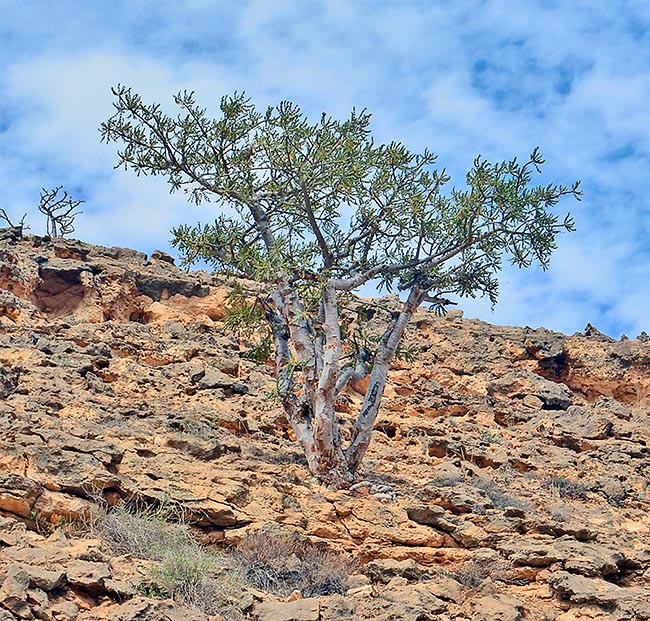
The incense (Boswellia sacra) is a 2-8 m small tree, ever more rare in nature, present, mainly on rocky slopes, in the desert zones of northern Somalia, the south-eastern Yemen and the southern Oman © Gianfranco Colombo
The Frankincense (Boswellia sacra Flueck 1867) is a Near Threatened (NT) species reported in the IUCN Red List 2008, present in northern Somalia, south-eastern Yemen and southern Oman, where it lives in the desert arid thickets, mainly on calcareous rocky slopes and on badlands.
The preferred habitat is the mountain slopes facing the sea, that in summer are shrouded by the mist coming from the strong summer evaporation of the sea water. The mist, with its humidity, in fact encourages the growth of a rich flora in spite of the absence of rain (fog oasis).
The name of the genus Boswellia honours the memory of the Scottish botanist Johann Boswell who described the plant, whilst the specific sacra comes from the Latin sacred, due to the traditional religious utilizations of the resin gotten from the plant. This genus, belonging to the family of the Burseraceae, includes about 30 species with African and Asian distribution.
For the prodution of the frankincense are utilized also Boswellia frereana, present in Somalia, Boswellia papyrifera, present in Ethiopia and Eritrea and Boswellia serrata, present in India, even if the resin produced by these species is not as prized as that of the Boswellia sacra.
Amongst the vulgar names, besides the incense (from the medieval Latin “incensus”, past participle of “incendere”, to burn, hence burnt), we find frankincense (“franc”, “true incense”, to distinguish it from the many perfumed resins pretended as incense, less reliable is the derivation from “incense of the Franks”, as its use in the western world should have been brought by the veterans of the Crusades, generically called Franks) and olibanum, from the Arabic al-lubán (“the milk”) or, maybe, from the Latin “oleum libani”, as also suggested by the old Greek name libanotos (λιβανωτός).
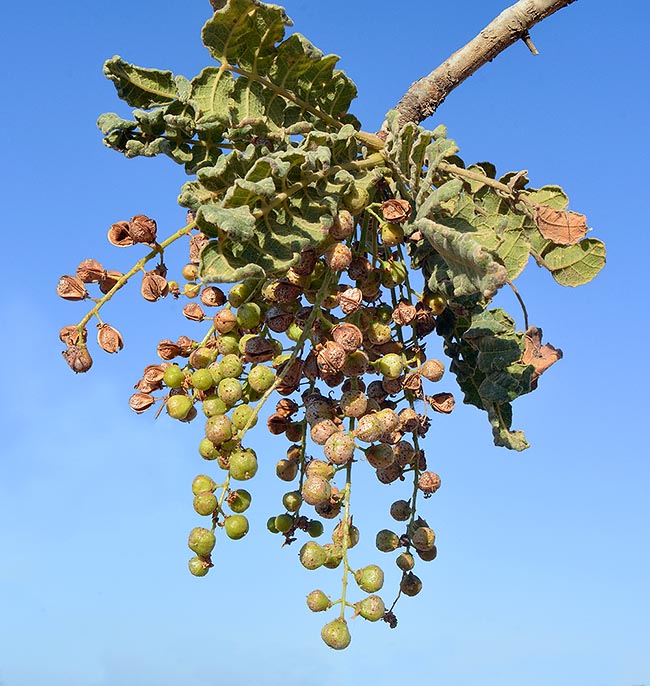
Branch with leaves and fruits at different ripening stages. They are about 1 cm capsules with 3-5 seeds © Colombo
The Boswellia sacra is a 2-8 metres tall deciduous tree.
It has one or more stems soon ramified, with branches that tend to bend downwards.
Papyraceous bark, desquamating. Often the trunk, especially in the specimens growing on rocky slopes, has at the base a pillowy bulging that increases the supporting surface and fosters the stability of the plant.
Compound, imparipinnate leaves, with 6-8 couples of opposite leaflets and one apical leaflet, gathered at the apex of the branches.
The about 7 mm flowers, have green calyx and five white-yellowish petals, have one ovary and 10 stamina and form inflorescences in axillar racemes.
It has a yellow nectariferous disc that while ripening turns red. The fruit is formed by an about 1 cm long capsule with 3-5 seeds.
Following wounds to the bark,it produces an abundant aromatic resin having protective and antiseptic functions.
The plant begins to produce the incense already from the third or fourth year of life, but a good harvest takes place starting from the ten years. Harvesting techniques similar to those currently practiced have been already described by the Greek botanist Theophrastus, around the year 300 B.C.
The harvesters, especially during the monsoon period, make on the lower branches and on the trunk some incisions from where gets out a whitish resin that solidifies forming teardrop-shaped drops that, after about two months, are enough big and hardened to be taken off. In order to get an optimum quality product, the incisions are repeated three times and the resin is collected only after the third.
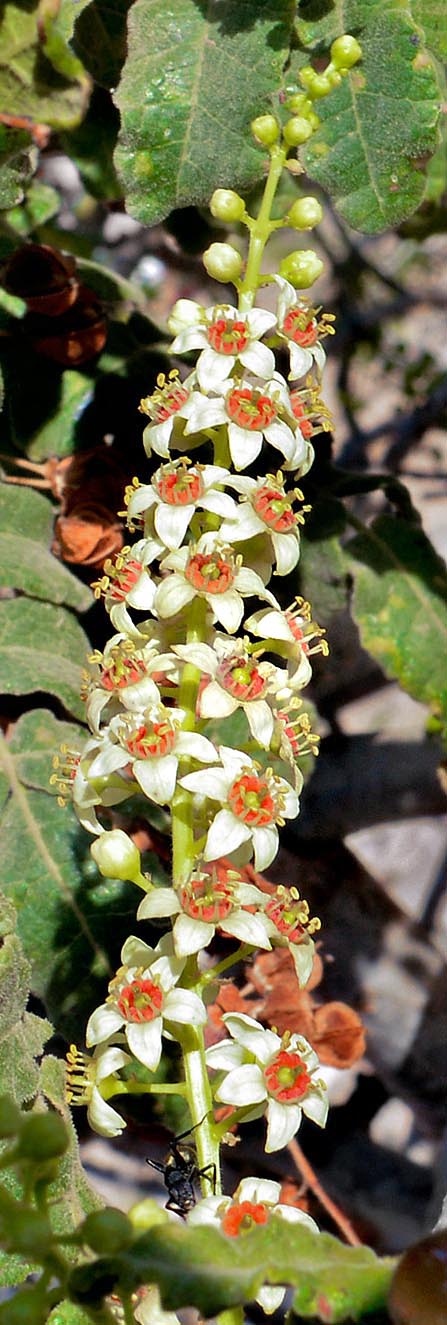
The numerous flowers have ten stamina and showy pistil at the centre of a yellow nectariferous disc that ripening turns red. They measure about 7 mm, with five white-yellowish petals, in long inflorescences of axillar racemes © Gianfranco Colombo
For the removal, the resin can be scratched from the bark or collected on the ground where it is left to drain.
Traditionally, the resin is conserved inside grottoes for seasoning. The product is selected according to its opacity and the best resin is the most opaque one.
Each tree can produce various kilos of resin per year. The yearly production of incense is estimated in various thousands of tons. An excessive harvesting weakens the tree reducing the production of flowers and seeds and, moreover, goats and dromedaries when grazing the leaves may cause damages.
History
The incense has a very long history for its medicinal, cosmetic and ritual utilizations. The trade dates back to more than 4000 years ago even if, until the mid-nineteenth century, in Europe the tree was unknown and it was thought that the resin should come from a Middle East juniper.
Egyptians imported the incense from the Land of Punt, that is Somalia, and in the Old Testament we find several quotations about its use and its derivation from the old kingdom of Sheba (probably present Yemen) from where the famous Queen did take it as a present to Solomon (it is said that the wonderful biblical “Song of Songs” narrates the love of the great King for the legendary Queen).
In ancient times the centre of the trade of the incense was the lost city of Ubar (probably corresponding to the city of Shisr, in present Oman), located along the “Incense Road” or “Spice Road” that connected the Horn of Africa and Arabia with the Mediterranean ports of Levant and with India. Even though at the time of Homer the incense was probably unknown to the Greeks, the historian Herodotus (V century B.C.) knew well its properties and origin, even if he was convinced that the harvesting was extremely dangerous due to the very poisonous snakes that defended the plant.
This idea of the danger of the collection lasted long time, possibly diffused by the traders to justify the high cost of the resin that, literally, was sold by weight in gold. It is said that in Rome, Nero for the funeral of the wife Poppaea had bought the equivalent of the whole annual production of incense coming from Arabia (strange way of showing his love by one who, after Tacitus, should have killed her with a kick on her pregnant belly).
Uses of incense
It is difficult to talk of the properties and the uses of the incense in Asia, as the term incense is quite vague and often refers to fumes produced by mixtures of resins and of perfumed woods such as the sandalwood. Here we shall refer to the true incense, or frankincense or oliban, resin of the Boswellia sacra and not to mixtures of resins and aromatic woods utilized for preparing the “incense sticks” widespread in the market.
Sacred and magical uses
Many peoples have done and still do use of the fumes of the incense in their religious rites: among those culturally closest to us we recall Sumerians ans Babylonians that considered the incense capable to appease the gods and the Egyptians, for whom the incense was strictly linked to the worhips for the dead and who thought that the resin drops of the incense were the tears of the gods.
Jews made great use of incense in their sacred rites and as perfume (see in the Old Testament the Psalm 141 “Let my prayer be counted as incense before you” and, especially, the “Song of Songs”).
For what Greece is concerned, Sappho (herself priestess of the goddess), in the VII century B.C., about the worship of Aphrodite writes: “Come to this holy temple, where your lovely apple grove stands, and your altars that flicker with incense. And below the apple branches, cold clear water sounds, everything shadowed by roses, and sleep that falls from bright shaking leaves“.
The incense is also linked to the myth of the Phoenix and Ovid, in the “Metamorphoses” tells us: “The phoenix….it does not live on seeds and herbs, but on drops of incense and odorous resins. When it has lived for five centuries, then builds a nest for itself in the top branches of a palm tree, lines it with cinnamon, nard and myrrh, settles on top, and ends its life among the perfumes”.
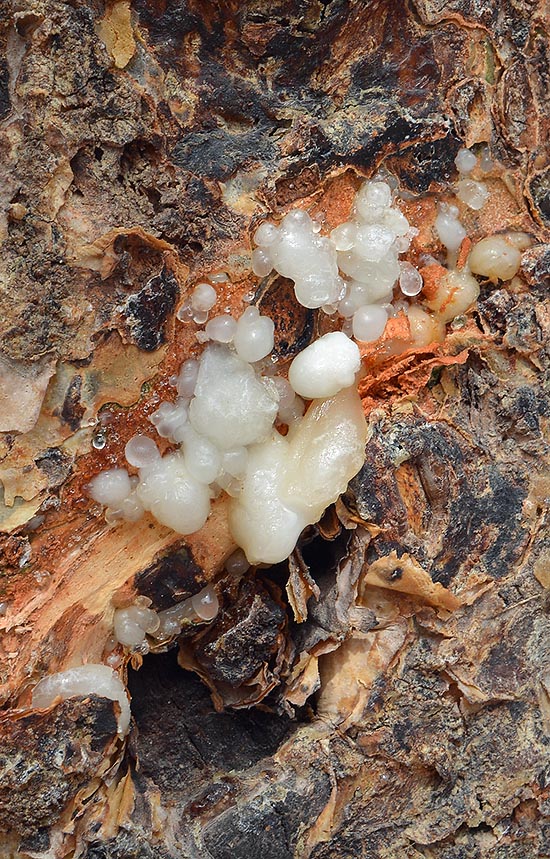
The resin, raw material of incense, is gotten from incisions on the trunk © Gianfranco Colombo
In the Christianity the incense is also linked to the history of the birth of Christ, with the Magi, one of them was rightly the incense, symbol of divinity, together with gold, royal symbol and the myrrh, symbol of the mortal nature, thence human, of the Christ.
It is possible that the ample use of the fumes of the incense in the rites is linked to its pharmacological properties capable to contribute to the spiritual exaltation associated with these events and hence facilitating the contact with the divinity.
After all, all over the world shamans and priests of every people always utilize psychoactive drugs to reach the mental status suitable for the rite, just think as example to the peyote, the ayahuasca, the psilocybe, the cannabis and the tobacco itself.
Let us now bring to mind a scene that many of us have lived: a church in the darkness, lit only by the oscillating flames of the candles, with the Gothic architectures that on top vanish into the dark, as if tending to the sky.
The celebrant, hieratic in his precious garments, is pronouncing incomprehensible words, while from the benches occupied by the monks covered by their frocks and with the face obscured by the hoods comes the monody of the Gregorian psalms, the censers oscillate sending clouds of fragrant incense smoke.
Even for an unbeliever it is very difficult to escape the charm of this mystical atmosphere that pushes us to the meditation and approaches us to the divinity. But the psychopharmacology does not have its own rôle in this scenography?
Recent studies have shown that one of the components of the incense, the incensole acetate, stimulates some receptors of the brain, called TRPV3, reducing the anxiety and the depression and causing pleasant and relaxing sensations.
Besides this, other components of the smoke such as the Boswellic acids induce an improvement in learning and memory.
These pharmacological effects of the incense furnish a biological basis for cultural traditions deeply rooted in many peoples.
Traditional uses
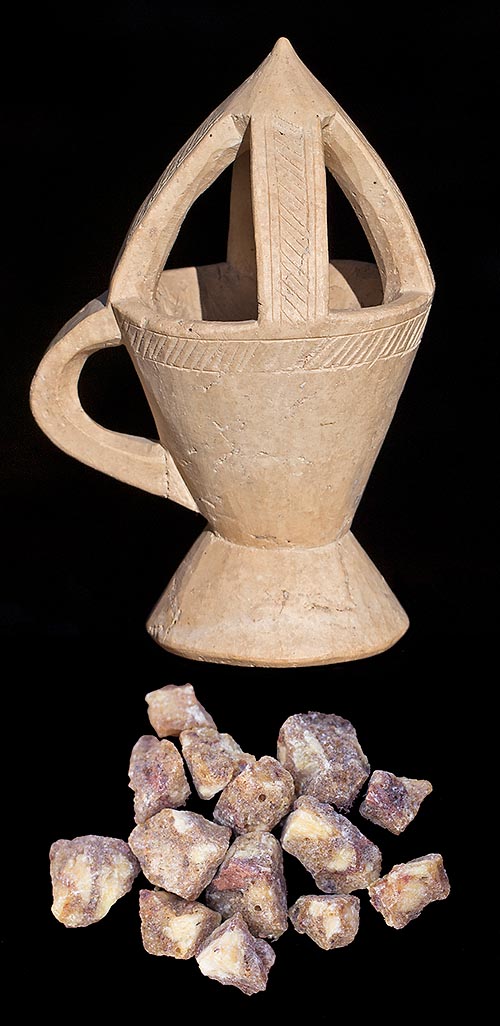
An artistic local incense burner and some grains ready to use after the seasoning in grottoes. The best resin, that looks like floured, is the most opaque © Giorgio Venturini
The incense has a very ample use in the traditional medicine, that utilizes, besides the resin, practically all parts of the plant. Many of the traditional utilizations find a good feedback in the modern knowledge of the pharmacological properties of the incense.
Only as an example we may mention the utilizations for diseases of the repiratory and digestive system and for the skin ailments. In particular, after a traditional middle eastern use, the resin is chewed to treat gastrointestinal problems (but swallowing it may cause damage to the stomach).
For the mastitis they suggest applications of the fresh resin boiled in the patient’s milk, whilst the minced bark is indicated for founds and burns or as eyes antiseptic, and the resin is chewed to fight toothache and to strengthen the gums. The essential oil is considered useful against the scorpions stings.
In the case of bone fractures recourse is done to the immobilization with slats of incense wood fixed with resin impregnated bandages.
In the Horn of Africa they used to burn incense during the delivery and then for 40 days in order to protect mother and newborn. Recourse is made also to the fumes of the resin as repellent for noxious insects and, generally, for rendering healthy the rooms and disinfect clothes and vessels for beverages.
Most curious is a a recipe for epilepsy based on resin mixed with white wine and hare lungs.
Unconventional uses
One of the oddest ones is the Chinese use of the incense clock (IX-X century) formed by powder of incense arranged to form a complicate drawing: once ignited the powder this burnt slowly and the time might be calculated by observing to what extent had gone the fire.
An alternative was the Japanese incense clock: in this when the fire reached a determined point it ignited a thread and dropped a weight. Until the twentieth century some geisha used these perfumed clocks for measuring the time dedicated to a client.
Incense pharmacology and modern medicine
The main components of the incense, chemically mainly terpenes, are resins, gums, Boswellic acids, incensole acetate and phellandrene. Among these substances of particular pharmacological interest are the Boswellic acids and the incensole acetate.
The Boswellic acids, in particular the AKBA (3-O-acetyl-11-keto-beta-boswellic acid), after various modern researches are endowed of an important anti-inflammatory activity, particularly useful in the treatment of chronic inflammatory diseases.
The Boswellia is now used successfully in the patients with ulcerative colitis or the Crohn’s disease and for other chronic inflammatory diseases borne by the bronchi or the joints. An important aspect of the activity of the Bowsellic acids is that of their mechanism of action, different from that of the traditional anti-inflammatories and apparently devoid of the side effects for the gastric mucosa. Furthermore, the leaves have diuretic activity without toxic effects on the kidneys.
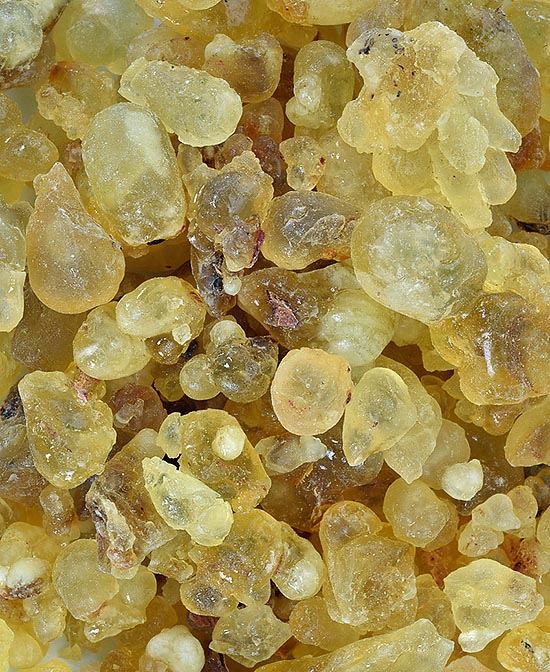
Uncommon and curious yellow resin to suck, like a candy, for various pathologies and to freshen breath. It has a good sweetish taste, but residues are not to be ingested © Gianfranco Colombo
We have already mentioned the important effects of the incensole acetate on the nervous system, that render it a substance capable to reduce anxiety and depression and to improve learning and memory, acting on particular nervous receptors.
Further studies have proved that the incensole is able to influence the functions of the pituitary-hypothalamic system and to regulate the expression of some genes in the nervous system leading to beneficial behavioural effects, potentially useful in the treatment of the depressive disorders.
Thanks also to the phellandrene contained in the resin, the fumes of the incense are also effective repellents for the insects.
About the incense fumes we must however recall the possible negative effects: if the exposition to the smoke can be beneficial under many points of view, we must also keep in consideration the generic damages caused by the inhalation of fumes, such as an increased risk of rhinitis.
Some studies suggest that the prolonged exposition can have also a mutagenic and cancirogenic effect but it should be noted that these are studies done on the smoke of chopsticks of eastern “incenses” whose chemical composition is different from that of the pure resin of the Boswellia.
In any case, the dangers coming from prolonged and repeated expositions to the fumes must not be underestimated.
Perfumes and Cosmetics
Besides the medicinal uses, the incense smoke since ancient times is utilized as perfume (the term perfume comes from the Latin “perfumus”, that is, “through the smoke”).
Clothes and furnishings, such as beverage vessels, are exposed to the smokes to perfume them as well as to disinfect them, practices still common in Somalia, where the grains of resin are burnt in a dedicated traditional burner, called dabqaad or girgire, hollowed in a soft stone, the sepiolite or foam of the sea (phyllosilicate) or also in soapstone, depending on the regions.
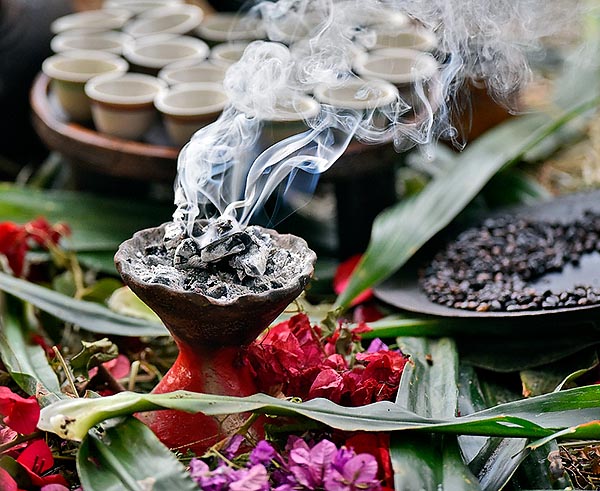
The fume of burnt incense favoues the mystical contact and enters the religious rites of many civilizations. But can be also a moment of conviviality as in this quaint cafeteria of Ethiopian plateau © G. Colombo
Incense oils are used to prepare industrially perfumes and soaps and the powdered resin, mixed with waxes, oils, powder of galena (lead sulfide, of dark grey colour) and other ingredients is used to prepare the kajal or kohl, eye cosmetic used since the most remote ancient times for decorating the eyelids.
The Egyptians, for instance, made great use of it, as shown by the depictions that present the eyes highly contoured. The Kajal is still now used in Middle East and in North Africa, for ornamental purpose as well as for protecting the eyes from the infections and is applied on the eyes of the children right from their birth.
Nero, well known vicious but also vain, used an ointment made with incense and wax to hide his eye bags after a lustful night.
An odd use of the incense is finally the one used for finding husband, that suggests to burn some incense and in the same time to write and recite the Psalm 45 of the Bible, staying under a pomegranate tree.
Synonyms: Boswellia carteri, Boswellia undulatocrenata, Boswellia bhaw-dajiana
→ To appreciate the biodiversity within the BURSERACEAE family please click here.
